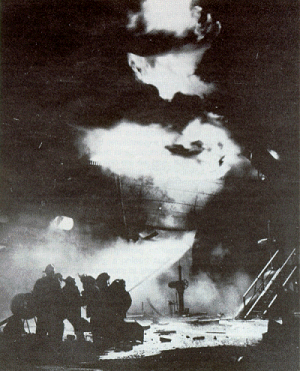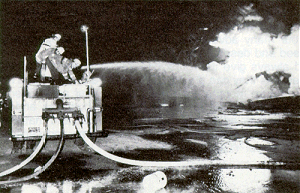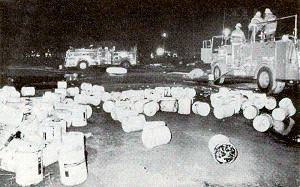
Light Water
Tender 34 is in operation as a wagon battery dumping
thousands of gallons of foam onto the burning super-structure.
Some of the empty cans of AFFF
"Light Water" concentrate are shown after
operation was stopped.
(Photo by Phil McBride.) |


4--THE
CALIFORNIA FIREMAN/FEBRUARY 1977
|
Wagon
48 of the Los Angeles City Fire Department was out on a rubbish
fire on Friday evening, December 17th, the third run of the
day. They were about nine blocks from "home,"
Fire Station 48 at 16th and Grand, in San Pedro.
A low rumble, not unlike an earthquake, was quickly followed by
a bright orange flash, and an explosion that sent a smoke cloud
mushrooming into the sky, and splintered windows all around
them.
Acting Captain James W. Frances picked up the mike and radioed
to OCD--the City's dispatch center at Fire Department
headquarters in downtown Los Angeles.
"We had a hell of an explosion in the harbor."
Already the boards at OCD were alive with calls, Dispatchers
doubled the normal first alarm assignment.
At
48's quarters, Captain Leo F. Christensen was serving as acting
battalion commander, in the absence of Battalion Commander John
Moore, who with other chefs, was "at Division," 25
miles away in south central Los Angeles.
Christensen and Moore's aide, Fireman Wayne Tanner, also felt
the rumble. As they stood up to investigate, the explosion
hit, ripping out six windows in the second floor of the fire
station.
They rolled out the door, with Truck and Pump 48 following.
"We thought it was a permanent installation in the outer
harbor area," said Tanner. "You overlook the
possibility that a tanker had gone off." Immediately
Christensen called for three additional task forces and three
more engines.
As the red sedan rounded 22nd street and headed into the harbor,
Christensen ordered more help.
Fire Boat 5 is located across West Channel from Berth 46, and
slightly up-channel, at Fort
MacArthur "lower reservation."
Their immediate radio report was the first
indication the responding crews received that a ship--and
a super-tanker--had exploded
PEOPLE
IN THE WATER
Boat 5 arrived to find two major portions of the tanker
Sansinena engulfed in fire. Men were in the water shouting
for help. |